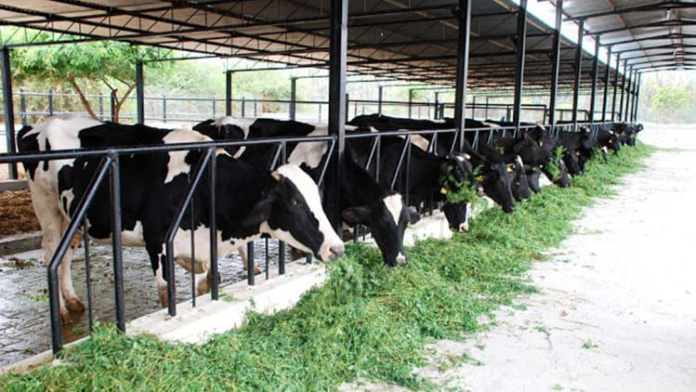Bovine Brucellosis: A major concern of dairy industry in India
Jigyasa Rana1, Shailesh Kumar Patel2, Shailendra Singh2
1Department of Veterinary Anatomy, Faculty of Veterinary and Animal Sciences, RGSC, BHU, Barkachha, Mirzapur, U.P. – 231001
2Department of Veterinary Pathology, College of Veterinary Science and A.H., Rewa, M.P. – 486001
Brucellosis is a zoonotic disease of great economic importance. This disease is globally and has a very negative impact on the livestock sector. The disease affects directly the financial status of farmers and indirectly the economy of the nation. Brucellosis is a bacterial disease caused by Brucells spp. and is associated with evolution of agricultural society with worldwide distribution. It is considered as one of the most prevalent zoonosis by Food and Agriculture Organization and World Health Organization (Corbel, 2006). The etiological agent of brucellosis is Gram-negative coccobacilli, Brucella abortus and occasionally by Brucella melitensis and Brucella suis. The disease is popularly known as undulant fever, Crimean fever, Mediterranean fever, remitting fever, Maltese fever, goat fever, Gibraltar fever and Bang disease (Hayoun et al. 2020).
The Brucella species are among those pathogenic bacteria which have ability to adapt to a wide range of host. The transmission mainly depends upon their primary hosts as they spread the infection to other animals of same species or sometimes other species also. (Moreno 2014). Mixed farming of cows, buffaloes, sheep and goats has increased the risk of brucellosis where small ruminants act as primary hosts for B. melitensis and cattle as spillover host (El-Wahab et al., 2019).
The disease is reflected by multiple clinical signs in the form of late abortion, reduced milk production, mastitis, stillbirths, weak calves, infertility, retention of placenta, necrotic placentitis, and endometritis. In addition, other signs include of fibrinous pleuritis coupled with interstitial pneumonia in neonatal calves. The Brucella spp. associated abortion rate may vary from 30-80% in susceptible herds (Kiros et al. 2016).
In India, the brucellosis is responsible for huge economic losses to livestock sector as a toll of US $ 3.4 billion. This disease causes an average loss of US $ 18.2 per buffalo followed by 6.8 per cattle, 0.7 per sheep, 0.6 per pig and 0.5 per goat (Singh et al. 2015). In this context, lack of general public awareness, unsafe husbandry practices, trading the Brucella spp. infected animals, lack of diagnostic facilities, unavailability of vaccines and poor herd management led to the persistence of brucellosis in India (Machavarapu et al., 2019).
Brucellosis is primarily transmitted through ingestion of infected feed and water, direct contact with aborted fetus, fetal membranes and genital secretions in animals. Infected bulls may also spread infection by natural service or artificial insemination. The organism is having affinity for genital tract of pregnant animals resulting in abortions during last term, retention of fetal membranes and infertility. Epididymitis and orchitis are commonly observed in male animals. The brucellosis is a common zoonotic disease with approximately 50,000 human cases annually worldwide (Pappas et al. 2006). The main route of transmission to humans is through raw, improperly pasteurized or unpasteurized dairy products and direct contact with infected tissues or secretions.
In conclusion, brucellosis is one of the most important diseases as far as economic importance is concerned. The burden of the disease among Indian dairy animals is huge and the only way to reduce the economic losses is a well implemented control measures. The effective control strategies of this disease include proper surveillance, routine monitoring, prevention of disease transmission and controlling the reservoir of infection by different methods including culling (Durrani et al. 2020). In addition, implementation of strict immunization protocols such as use of suitable smooth live vaccines, reliable diagnostic tools, mass vaccination of large population, along with consistent culling of Brucella-positive animals is crucial for effective management of brucellosis. Vaccination of animals is recommended in highly endemic areas. B. abortus strains 19 and RB51 are considered as effective attenuated vaccines against infection by B. abortus. Effective prevention and control of this disease is possible by increasing public awareness campaigns and applying hygienic livestock practices. Active and well harmonized co-operation between veterinary services and medical practice is required to effectively control the disease.
References:
- Corbel MJ. 2006. Brucellosis in humans and animals. Produced by the World Health Organization in collaboration with the Food and Agriculture Organization of the United Nations and World Organization for Animal Health. ISBN 9241547138.
- Hayoun MA, Smith ME, Shorman M. 2020. StatPearls [Internet]. Treasure Island (FL): StatPearls Publishing.
- El-Wahab EWA, Hegazy Y, Wael F, Mikeal A, Kapaby AF, Abdelfatah M, Bruce M, Eltholth MM. 2019. Knowledge, attitudes and practices (KAPs) and risk factors of brucellosis at the human-animal interface in the Nile Delta, Egypt. BioRxiv.607655.
- Moreno E. 2014. Retrospective and prospective perspectives on zoonotic brucellosis. Front Microbiol. 5:213. doi: 10.3389/fmicb.2014.00213.
- Kiros A, Asgedom H, Abdi RD. 2016. A review on bovine brucellosis: Epidemiology, diagnosis and control options. ARC J Anim Vet Sci. 2(3):8-21.
- Machavarapu M, Poonati R, Mallepaddi PC, Gundlamadugu V, Raghavendra S, Polavarapu KKB, Polavarapu R. Endemic brucellosis in indian animal and human populations: A billion dollar issue. J Curr Trends Biotechnol Pharm. 2019;13:112-123.
- Singh BB, Dhand NK, Gill JP 2015. Economic losses occurring due to brucellosis in Indian livestock populations. Prev Vet Med. 119(3-4):211-215.
- Pappas G, Papadimitriou P, Akritidis N, Christou L, Tsianos EV. 2006. The new global map of human brucellosis. Lancet Infect Dis. 6: 91-99.
- Durrani AZ, Usman M, Kazmi Z and Husnain M. 2020. Book chapter-Evaluation of Therapeutic Trials in Bovines. In:New Insight into Brucella Infection and Foodborne Diseases. doi: 10.5772/intechopen. 86325.



